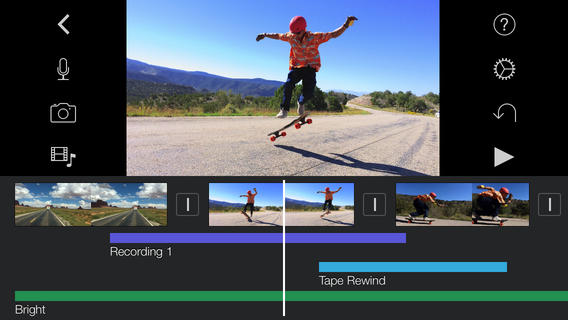Home > Articles > Digital Audio, Video
To reverse video: When you reverse video, its length stays the same; it plays at the same speed, only backward. In the Project browser, double-click a video clip you want to reverse, or select one or more video clips and then double-click. How to turn on imac computer. In the Clip inspector that opens, select the Reverse checkbox, and then click Done. Reverse video clips in iMovie. Reversing clips within a movie is often used for dramatic or comedic effect. It can offer a GIF-like replay of a crash, funny moment, expression or whatever you like. Used sparingly, it can add a real flavor to a movie.
Like this article? We recommend
Like this article? We recommend
Although the hardware of mobile devices improves each year, we expect most of the apps we run on them to be 'light,' feature-limited versions. iMovie for iOS, Apple's video editor for iPad, iPhone, and iPod touch, doesn't yet match every capability of iMovie on the Mac, but you'd be surprised at some of the things it can do. If you haven't taken a look at iMovie for iOS in a while, a few non-obvious advanced features are tucked into its simple interface.
Crop a Video
When you add a still photo to a video project, it's given the Ken Burns effect—the image is cropped, and the virtual camera zooms in or out. What you may not realize is that you can also crop a video clip to reframe the shot. Here's how:
- In the timeline, tap the video clip you want to edit.
- Tap the magnifying glass button in the lower-right corner of the viewer.
- Pinch the viewer with two fingers to zoom in or out, and reposition the frame by dragging with one finger.
The entire clip now plays with the framing you set (see Figure 1). If you're not happy with it, select the clip again and double-tap the magnifying glass button to go back to the original crop.
Figure 1 Reframe a video clip by zooming in on it.

Create Picture-in-Picture and Split-Screen Shots
Here's an example of a cool feature that you might miss if you didn't know it was there. iMovie supports picture-in-picture and split-screen scenes:
- Position the playhead at the point at which you want the additional video clip to begin.
- In the video library, tap the clip you want to add; you can optionally define the portion of the clip to add by dragging the left and right yellow handles.
- Normally, you'd tap the Add button (the arrow) to place the clip in the timeline. Instead, tap the ellipsis (…) button to reveal more options.
- Tap the button for the effect you want to use (from left to right): as audio only, as a cutaway, as a picture-in-picture clip, or as a split-screen clip. The new clip appears above the timeline.
- To adjust the properties of the new clip, select it in the Timeline. You can reposition it or switch to a different effect (see Figure 2).
Figure 2 Choose what effect the clip will have when adding it.
Apply an Audio Fade Within a Clip
Lastly, here's an old annoyance with previous versions of iMovie for iOS. You want to fade the audio of a clip so it's not abruptly cut when the clip appears or ends. The solution isn't as elegant as the method of accomplishing this in iMovie for Mac, but it works:
Imovie Reverse Clip
- Tap to select the clip you want to edit.
- Tap the Audio button in the lower-left corner to view the audio options.
- Tap the Detach button. A copy of the audio portion of the clip appears below the video clip, and the clip's original audio is muted.
- Tap the Fade button that appears at the bottom of the screen.
- Drag the yellow triangle at the start or end of the clip to set the duration of the fade (see Figure 3).
Figure 3 Apply an audio fade to a detached copy of a clip's audio track.
Final Thoughts
Those are just three non-obvious features of iMovie for iOS. You can find more, plus a thorough look at shooting and editing video using iOS devices, in my book iPad and iPhone Video: Film, Edit, and Share the Apple Way.
About the Author: Jeff Carlson
Flip Video Iphone
Jeff Carlson is a columnist for the Seattle Times, a senior editor of the weekly electronic newsletter TidBITS, and a frequent contributor to publications such as Macworld and Photoshop Elements Techniques magazines. He is also the author of numerous books, including three editions of The iPad Pocket Guide, iPad for Photographers, The iMovie '11 Project Book, Mac OS X 10.7 Lion Pocket Guide, and Canon PowerShot G12: From Snapshots to Great Shots. Find more information about Jeff at jeffcarlson.com and necoffee.com, and follow him on Twitter at @jeffcarlson.

